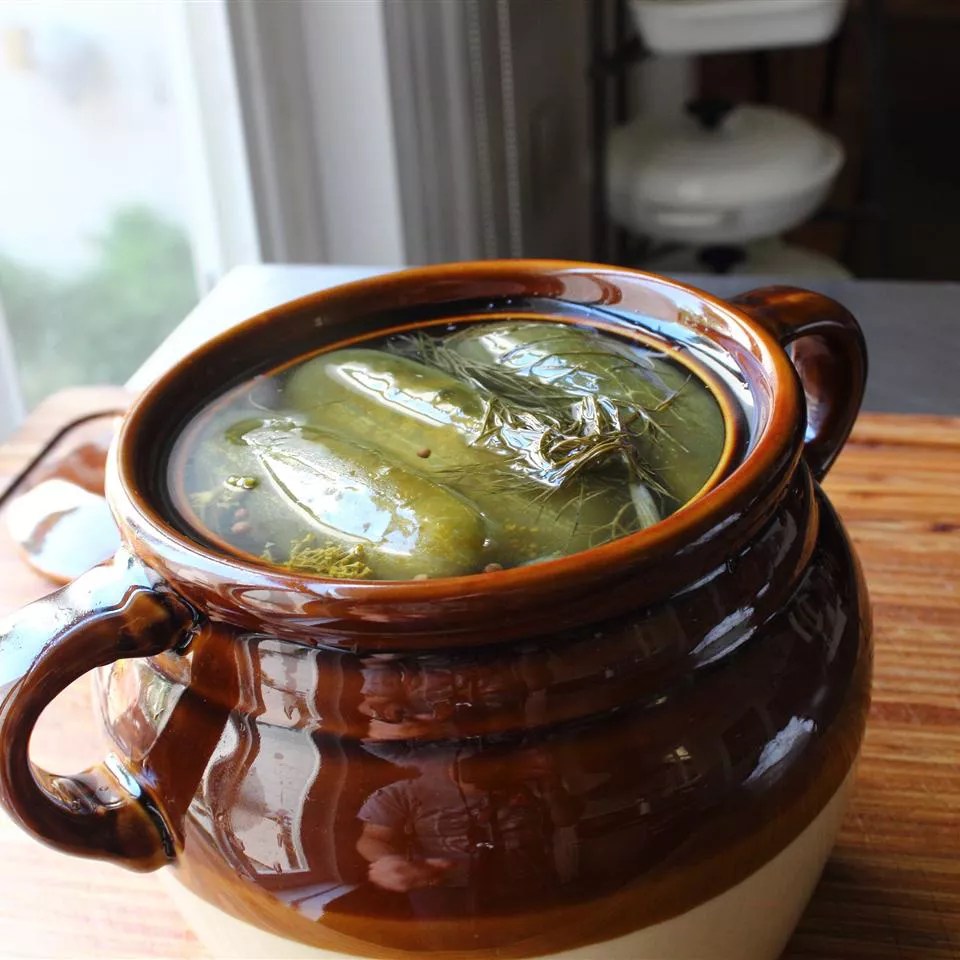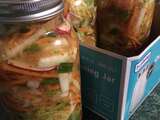Recipe Details
Ingredients
-
8cupscold fresh water
-
8tablespoonskosher salt
-
4clovespeeled garlic
-
4whole cloves
-
3bay leaves, or more to taste
-
2teaspoonswhole coriander seeds
-
2teaspoonswhole black peppercorns
-
1bunchfresh, flowering dill weed
-
2poundsvery fresh Kirby cucumbers, washed thoroughly
Cooking Directions
-
Combine water, salt, and garlic in a large saucepan. Add cloves, bay leaves, coriander seeds, and peppercorns. Stir until salt is dissolved. Heat over low heat for just a few minutes to bring water to room temperature. The water should not be warm.
-
Select a jar or crock large enough to hold the cucumbers, spices, and some brine. Place some dill flowers over the bottom and top with a few cucumbers. Alternate layers of dill and cucumbers, ending with a layer of dill. Pour pickling brine into the crock. Gently tap or shake the crock to eliminate any air bubbles. Place a small ramekin on the pickles to weigh them down and ensure they stay below the surface of the brining liquid. Top with more brine and cover the crock. Reserve any extra brine to use during the fermentation process.
-
Place the crock where it can ferment at a temperature between 65 and 75 degrees F (18 to 24 degrees C). Let pickles ferment for a week, checking every day to ensure they remain submerged; add more brine if necessary. Small bubbles may appear; this is a normal product of the fermentation process.
-
After about eight days, you can skim off the foam. Test a pickle for flavor and crunch. You can continue fermenting them for a couple more days or, if you like them at this point, transfer pickles to a large jar. Fill the jar with the brine from the fermentation process. Cover and store finished pickles in the refrigerator.

Cooking Tips:
You need exactly 80 grams of salt for 8 cups of water. The brand I use weighs about 10 grams per tablespoon, but yours may vary, so it’s best to use a scale.
Be sure to check every day, as these can ferment fast. They are ready when you like the taste. If you go too far, they’ll start to get soft and hollow on the inside.
This recipe makes extra brine so you can keep the level topped off as you check each day.
I don’t like a lot of spices in my pickles, so I think the amounts listed here are fairly puny compared to most recipes. Feel free to find one of the many pickling spices recipes online, and use that instead.
Editor’s Note:
Nutrition data for this recipe includes the full amount of brine ingredients. The actual amount consumed will vary.
Nutrition Facts
| Full Nutrition Label | |
|---|---|
| Servings Per Recipe16 | |
| Calories12 | |
| % Daily Value * | |
| Total Fat 0g |
0% |
| Sodium 2887mg |
126% |
| Total Carbohydrate 3g |
1% |
| Dietary Fiber 1g |
2% |
| Total Sugars 1g |
|
| Protein 1g |
1% |
| Vitamin C 4mg |
4% |
| Calcium 22mg |
2% |
| Iron 0mg |
2% |
| Potassium 107mg |
2% |
* Percent Daily Values are based on a 2,000 calorie diet. Your daily values may be higher or lower depending on your calorie needs.
** Nutrient information is not available for all ingredients. Amount is based on available nutrient data.
(-) Information is not currently available for this nutrient. If you are following a medically restrictive diet, please consult your doctor or registered dietitian before preparing this recipe for personal consumption.
Powered by the ESHA Research Database © 2018, ESHA Research, Inc. All Rights Reserved







